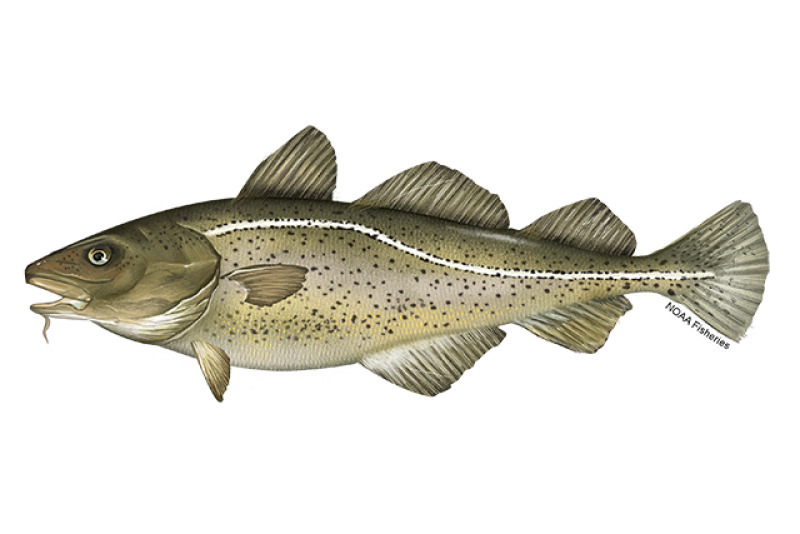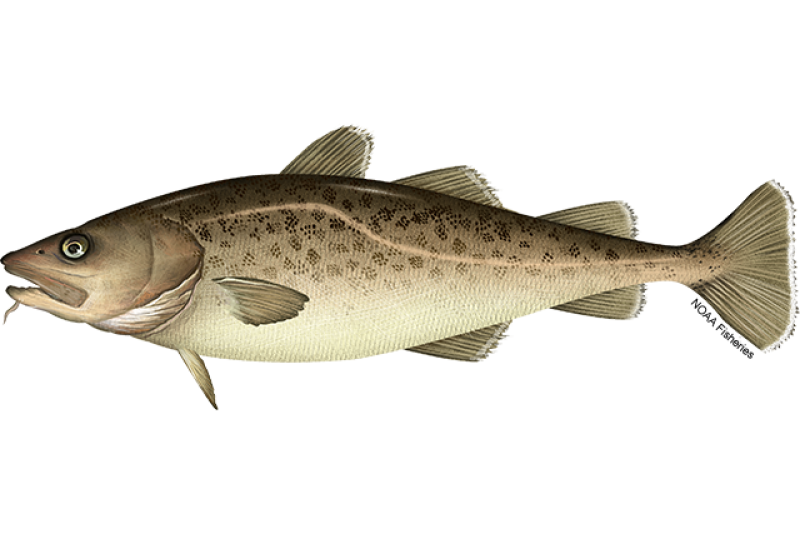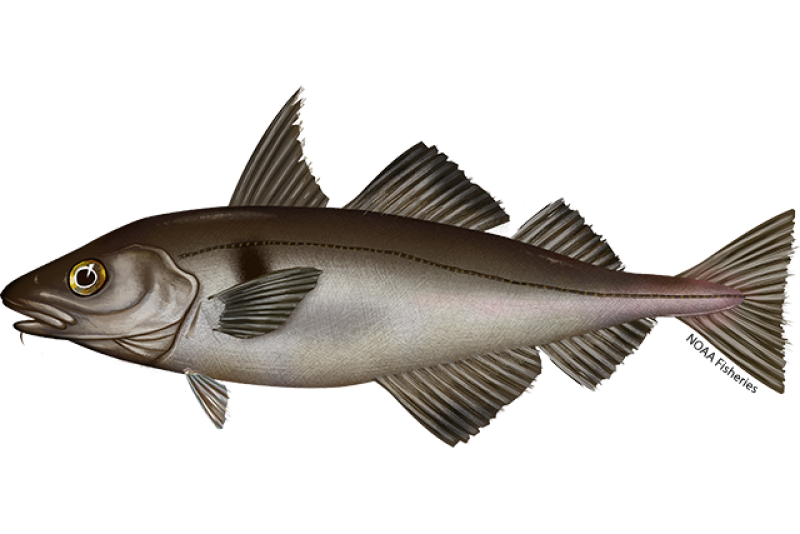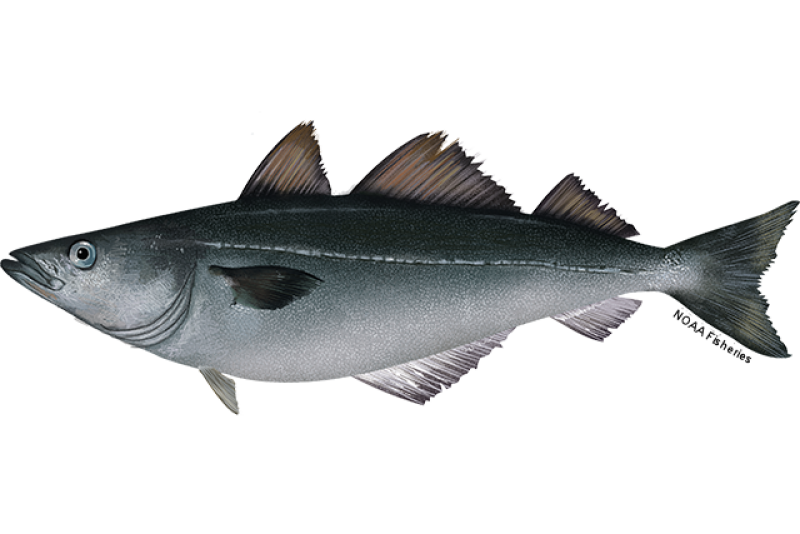 Atlantic cod fish. Credit: NOAA Fisheries
Atlantic cod fish. Credit: NOAA Fisheries
Atlantic cod fish. Credit: NOAA Fisheries
About the Species
 Atlantic cod fish. Credit: NOAA Fisheries
Atlantic cod fish. Credit: NOAA Fisheries
Atlantic cod fish. Credit: NOAA Fisheries
In the Northwest Atlantic, cod range from Greenland to Cape Hatteras, North Carolina. In U.S. waters, cod is most common on Georges Bank and in the western Gulf of Maine. Cod is an iconic fish of New England and in recent years, Atlantic cod stocks in our region have declined dramatically. NOAA Fisheries is working to rebuild this population.

Population
The Gulf of Maine and Georges Bank stocks are overfished, but the fishing rate established under rebuilding plans promotes population growth.

Fishing Rate
Reduced to end overfishing.

Habitat Impact
Area closures and gear restrictions protect habitat that are affected by some kinds of trawl gear.

Bycatch
Regulations and the use of modified fishing gear reduce bycatch.
Population Status
- There are two stocks of Atlantic cod: Gulf of Maine and Georges Bank stocks. According to the most recent stock assessments
- The Gulf of Maine stock is overfished and subject to overfishing (2021 stock assessment). Summary stock assessment information can be found on Stock SMART.
- The Georges Bank stock is overfished and subject to overfishing (2021 stock assessment). Summary stock assessment information can be found on Stock SMART.
- Historically, cod was so abundant off New England that early explorers named Cape Cod for the fish. Furthermore, Gloucester was established by a colonial charter issued to profit from cod fishing, and a painted “sacred cod” carved from pine has hung in the Massachusetts state house since 1784 as a symbol of prosperity.
- Due to high fishing pressure throughout the latter part of the 20th century, there are fewer fish in the U.S. stocks of Atlantic cod than the average for the past four decades.
- A primary source of rebuilding potential is the number of young fish coming into the population (recruitment). Over the past 20 years, recruitment has varied for the Gulf of Maine stock, and has been well below average for the Georges Bank stock.
Appearance
- Atlantic cod are heavy-bodied with a large head, blunt snout, and a distinct barbel (a whisker-like organ, like on a catfish) under the lower jaw.
- Their coloring varies, ranging from light yellowish-green to red and olive, usually with darker speckles on the head, fins, tail, and body. The belly is light colored and usually spotless. Individuals can change color readily.
- Cod have an obvious lateral line (the faint line that runs lengthwise down each side of the fish).
Biology
- Atlantic cod can live more than 20 years.
- They can grow up to 51 inches and 77 pounds.
- They are capable of reproducing at 2 to 3 years old, when they are between 12 and 16 inches long.
- Cod spawn near the ocean floor from winter to early spring.
- Larger females can produce 3 to 9 million eggs when they spawn.
- They are top predators in the bottom ocean community, feeding on a variety of invertebrates and fish.
Where They Live
Range
- In the Northwest Atlantic, cod range from Greenland to Cape Hatteras, North Carolina.
- In U.S. waters, cod is most common on Georges Bank and in the western Gulf of Maine.
Habitat
- Atlantic cod live near the ocean floor along rocky slopes and ledges.
- They prefer to live in cold water, at depths of around 30 to 500 feet, on bottoms with coarse sediments, rather than on finer mud and silt.
Fishery Management
- There are two stocks of Atlantic cod in U.S. waters, the Gulf of Maine and Georges Bank stocks.
- NOAA Fisheries and the New England Fishery Management Council manage Gulf of Maine cod. NOAA Fisheries and the New England Fishery Management Council collaborate with Canada to jointly manage Georges Bank cod, because the stock spans the international boundary.
- Atlantic cod, along with other groundfish in New England waters, are managed under the Northeast Multispecies Fishery Management Plan, which includes:
- Permitting requirements for commercial vessels.
- Separate management measures for recreational vessels.
- Year-round and seasonal area closures to protect spawning fish and habitat.
- Minimum fish sizes to prevent harvest of juvenile fish.
- Annual catch limits, based on best available science.
- An optional sector (catch share) program can be used for cod and other groundfish species. The sector program allows fishermen to form harvesting cooperatives and work together to decide when, where, and how they harvest fish.
- A rebuilding plan to rebuild the Gulf of Maine stock to the target population level is in place with a target date of 2033.
- A rebuilding plan to rebuild the Georges Bank stock to the target population level is in place with a target date of 2026.
Harvest
- Commercial fishery:
- In 2023, commercial landings of Atlantic cod totaled 1 million pounds and were valued at $2.2 million, according to the NOAA Fisheries commercial fishing landings database.
- Gear types, habitat impacts, and bycatch:
- Cod are commonly harvested using trawl nets, gillnets, bottom longlines, and rod and reel.
- Gillnets, longlines, and rod and reel used to harvest cod have little to no impact on habitat.
- Closed areas and gear restrictions reduce habitat impacts from trawl nets.
- Fishermen follow management measures designed to reduce interactions with marine mammals, including gear modifications, seasonal closures, and use of marine mammal deterrents.
- Recreational fishery:
- Cod are highly prized by recreational fishermen. They are commonly harvested by anglers using lures or bait. Fishing occurs year-round.
- In 2022, recreational anglers landed 380,000 pounds of Atlantic cod, according to the NOAA Fisheries recreational fishing landings database.
- Regulations include minimum fish sizes, possession limits, and closed seasons.
Scientific Classification
- In the Northwest Atlantic, cod range from Greenland to Cape Hatteras, North Carolina.
- In U.S. waters, cod is most common on Georges Bank and in the western Gulf of Maine.
- Atlantic cod live near the ocean floor along rocky slopes and ledges.
- They prefer to live in cold water, at depths of around 30 to 500 feet, on bottoms with coarse sediments, rather than on finer mud and silt.
Fishery Management
- There are two stocks of Atlantic cod in U.S. waters, the Gulf of Maine and Georges Bank stocks.
- NOAA Fisheries and the New England Fishery Management Council manage Gulf of Maine cod. NOAA Fisheries and the New England Fishery Management Council collaborate with Canada to jointly manage Georges Bank cod, because the stock spans the international boundary.
- Atlantic cod, along with other groundfish in New England waters, are managed under the Northeast Multispecies Fishery Management Plan, which includes:
- Permitting requirements for commercial vessels.
- Separate management measures for recreational vessels.
- Year-round and seasonal area closures to protect spawning fish and habitat.
- Minimum fish sizes to prevent harvest of juvenile fish.
- Annual catch limits, based on best available science.
- An optional sector (catch share) program can be used for cod and other groundfish species. The sector program allows fishermen to form harvesting cooperatives and work together to decide when, where, and how they harvest fish.
- A rebuilding plan to rebuild the Gulf of Maine stock to the target population level is in place with a target date of 2033.
- A rebuilding plan to rebuild the Georges Bank stock to the target population level is in place with a target date of 2026.
Harvest
- Commercial fishery:
- In 2023, commercial landings of Atlantic cod totaled 1 million pounds and were valued at $2.2 million, according to the NOAA Fisheries commercial fishing landings database.
- Gear types, habitat impacts, and bycatch:
- Cod are commonly harvested using trawl nets, gillnets, bottom longlines, and rod and reel.
- Gillnets, longlines, and rod and reel used to harvest cod have little to no impact on habitat.
- Closed areas and gear restrictions reduce habitat impacts from trawl nets.
- Fishermen follow management measures designed to reduce interactions with marine mammals, including gear modifications, seasonal closures, and use of marine mammal deterrents.
- Recreational fishery:
- Cod are highly prized by recreational fishermen. They are commonly harvested by anglers using lures or bait. Fishing occurs year-round.
- In 2022, recreational anglers landed 380,000 pounds of Atlantic cod, according to the NOAA Fisheries recreational fishing landings database.
- Regulations include minimum fish sizes, possession limits, and closed seasons.
Scientific Classification
| Kingdom | Animalia | Phylum | Chordata | Class | Actinopterygii | Order | Gadiformes | Family | Gadidae | Genus | Gadus | Species | morhua |
|---|
Last updated by NOAA Fisheries on 03/20/2025
Featured News
 The NOAA research vessel Gloria Michelle conducts groundfish surveys in New England, an important mission to support science-based fisheries management. Photo credit: NOAA Fisheries
The NOAA research vessel Gloria Michelle conducts groundfish surveys in New England, an important mission to support science-based fisheries management. Photo credit: NOAA Fisheries
As Fishing Season Opens, NOAA Implements Emergency Action to Ensure Uninterrupted Northeast Fisheries
 Chef Tyler Hadfield’s Curried Skate Wings with Tomato-Masala Chutney
Chef Tyler Hadfield’s Curried Skate Wings with Tomato-Masala Chutney
Ring In the New Year With These Crowd-Favorite Seafood Recipes
 Juvenile coho salmon. Credit: iStock
Juvenile coho salmon. Credit: iStock
NOAA Fisheries Releases 2023 Status of Stocks

Seafood Facts

Is Atlantic Cod Sustainable?
Although populations are well below target levels, U.S. wild-caught Atlantic cod is still a smart seafood choice because it is sustainably managed under a rebuilding plan that allows limited harvest by U.S. fishermen.
Availability
Year-round.
Source
Wild-caught from Maine to Virginia.
Taste
Atlantic cod has a mild clean flavor. It is sweeter than Pacific cod.
Texture
Cod has large flakes. It's less firm than haddock.
Nutrition Facts
Servings: 1; Serving Weight: 100 g; Calories: 82; Protein: 17.81 g; Total Fat: 0.67 g; Total Saturated Fatty Acids: 0.131 g; Carbohydrate: 0 g; Total Sugars: 0 g; Total Dietary Fiber: 0 g; Cholesterol: 43 mg; Selenium: 33.1 mcg; Sodium: 54 mgCod Recipes
Looking for some ways to add cod into your rotation? If you need cooking inspiration, browse these recipes for Alaska cod potato-cakes, easy oven-fried fish sticks, and more!

Last updated by NOAA Fisheries on 03/20/2025
Seafood News
 Fresh-caught taʻape on ice. Credit: Conservation International Hawaiʻi.
Fresh-caught taʻape on ice. Credit: Conservation International Hawaiʻi.
Reducing Waste and Feeding Communities in Hawaiʻi with a Whole Fish Approach
 Chef Tyler Hadfield’s Curried Skate Wings with Tomato-Masala Chutney
Chef Tyler Hadfield’s Curried Skate Wings with Tomato-Masala Chutney
Ring In the New Year With These Crowd-Favorite Seafood Recipes
 NOAA Fisheries, in collaboration with Blue Ocean Mariculture, is conducting a multi-year pilot study to evaluate observational methods and tools for studying Hawaiian monk seal behavior. Courtesy of Blue Ocean Mariculture
NOAA Fisheries, in collaboration with Blue Ocean Mariculture, is conducting a multi-year pilot study to evaluate observational methods and tools for studying Hawaiian monk seal behavior. Courtesy of Blue Ocean Mariculture
AI Meets Aquaculture to Study Hawaiian Monk Seal Interactions With Net Pens
 Tonya Wick aboard a fishing vessel at sea in 1998. Photo courtesy of Tonya Wick
Tonya Wick aboard a fishing vessel at sea in 1998. Photo courtesy of Tonya Wick
Management Overview
Atlantic cod is managed under the Northeast Multispecies (Groundfish) Fishery Management Plan along with 12 other species of groundfish. Collectively, these 13 species are referred to as the Northeast multispecies complex.
Learn more about the Northeast multispecies complex and its management
Last updated by NOAA Fisheries on 03/20/2025
Documents
Age Determination Methods for Northwest Atlantic Species
This manual documents age determination techniques used by staff at the Woods Hole Laboratory to…
Data & Maps
Accuracy and Precision of Fish Ages - Northeast
It is important to ensure consistency in fish ages used in fish population assessments. The Fishery…
Research
Ecosystem and Socioeconomic Profile Development and Reports
Status of Ecosystem and Socioeconomic Profiles for Northeast fishery stock assessments.
Transboundary Resources Assessment Committee Documents
Peer-reviewed stock assessments performed by Transboundary Resources Assessment Committee, a…
Passive Acoustics Research Group News & Media
Our Passive Acoustics Research Group frequently makes the news. This page links to articles and other media featuring our staff and their research.
Outreach & Education
Fisheries of the Northeast
More than 100 species, including finfish, shellfish, urchins, and seaweeds, are landed in the…
Last updated by NOAA Fisheries on 03/20/2025





